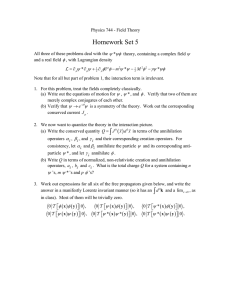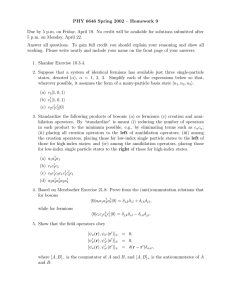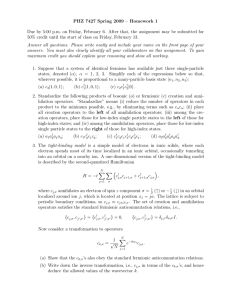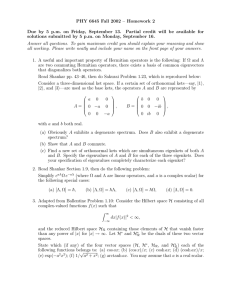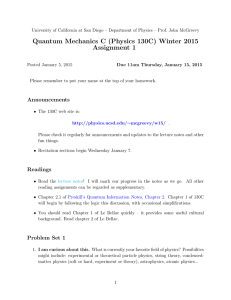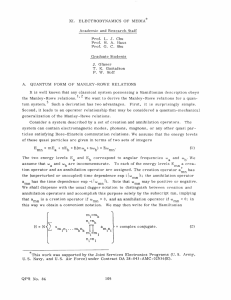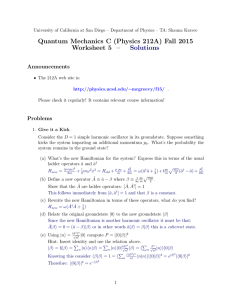PHZ 7427 Spring 2010 – Homework 1
advertisement
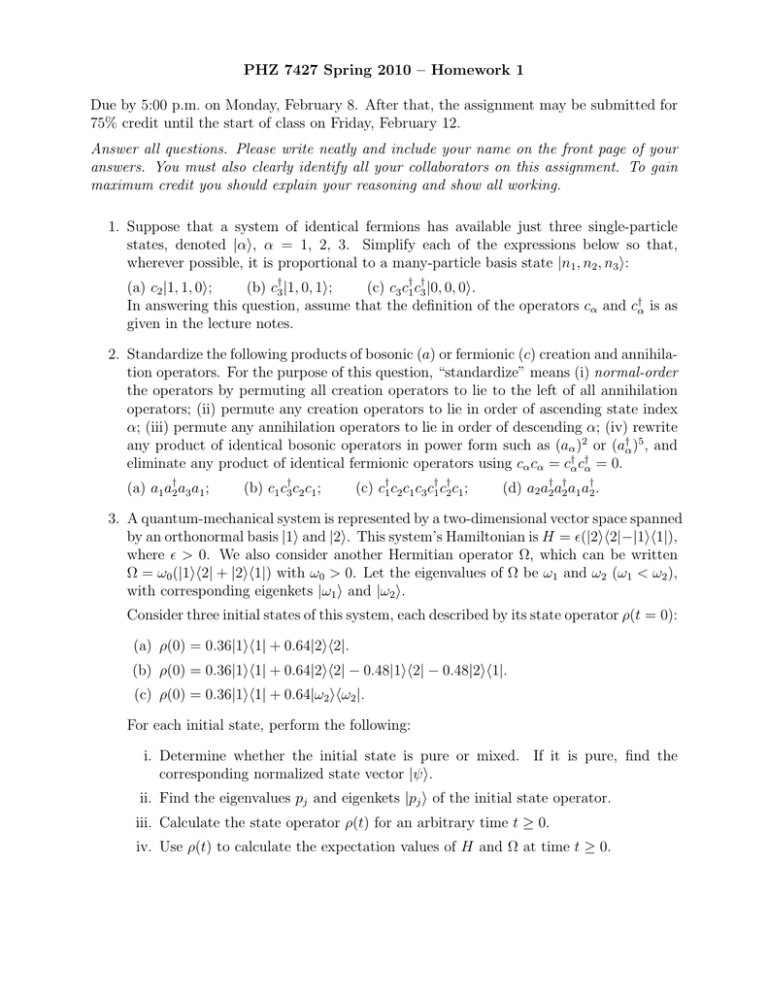
PHZ 7427 Spring 2010 – Homework 1 Due by 5:00 p.m. on Monday, February 8. After that, the assignment may be submitted for 75% credit until the start of class on Friday, February 12. Answer all questions. Please write neatly and include your name on the front page of your answers. You must also clearly identify all your collaborators on this assignment. To gain maximum credit you should explain your reasoning and show all working. 1. Suppose that a system of identical fermions has available just three single-particle states, denoted |αi, α = 1, 2, 3. Simplify each of the expressions below so that, wherever possible, it is proportional to a many-particle basis state |n1 , n2 , n3 i: (b) c†3 |1, 0, 1i; (c) c3 c†1 c†3 |0, 0, 0i. (a) c2 |1, 1, 0i; In answering this question, assume that the definition of the operators cα and c†α is as given in the lecture notes. 2. Standardize the following products of bosonic (a) or fermionic (c) creation and annihilation operators. For the purpose of this question, “standardize” means (i) normal-order the operators by permuting all creation operators to lie to the left of all annihilation operators; (ii) permute any creation operators to lie in order of ascending state index α; (iii) permute any annihilation operators to lie in order of descending α; (iv) rewrite any product of identical bosonic operators in power form such as (aα )2 or (a†α )5 , and eliminate any product of identical fermionic operators using cα cα = c†α c†α = 0. (a) a1 a†2 a3 a1 ; (b) c1 c†3 c2 c1 ; (c) c†1 c2 c1 c3 c†1 c†2 c1 ; (d) a2 a†2 a†2 a1 a†2 . 3. A quantum-mechanical system is represented by a two-dimensional vector space spanned by an orthonormal basis |1i and |2i. This system’s Hamiltonian is H = (|2ih2|−|1ih1|), where > 0. We also consider another Hermitian operator Ω, which can be written Ω = ω0 (|1ih2| + |2ih1|) with ω0 > 0. Let the eigenvalues of Ω be ω1 and ω2 (ω1 < ω2 ), with corresponding eigenkets |ω1 i and |ω2 i. Consider three initial states of this system, each described by its state operator ρ(t = 0): (a) ρ(0) = 0.36|1ih1| + 0.64|2ih2|. (b) ρ(0) = 0.36|1ih1| + 0.64|2ih2| − 0.48|1ih2| − 0.48|2ih1|. (c) ρ(0) = 0.36|1ih1| + 0.64|ω2 ihω2 |. For each initial state, perform the following: i. Determine whether the initial state is pure or mixed. If it is pure, find the corresponding normalized state vector |ψi. ii. Find the eigenvalues pj and eigenkets |pj i of the initial state operator. iii. Calculate the state operator ρ(t) for an arbitrary time t ≥ 0. iv. Use ρ(t) to calculate the expectation values of H and Ω at time t ≥ 0. 4. Consider a uniform gas of electrons that interact via a screened Coulomb potential u(r) = V0 −r/a e r ⇔ u(q) = 4πV0 . + a−2 q2 (a) Show that the single-particle wave functions φk (r) = V −1/2 eik·r solve the HartreeFock equations in a system of volume V → ∞, and evaluate the direct and exchange terms in the energy shift ∆εk . Hence, find the Fermi energy εF . (b) Show that the exchange contribution to εF is negligible compared to the direct contribution in the weak-screening limit kF a 1, but that the two contributions are comparable in the strong-screening regime kF a 1. (c) Two different effective masses m∗1 and m∗2 can be defined via the expansion ∂εk 1 ∂ 2 εk + ... + (∆k)2 ∂k 2 ∂k 2 h̄2 k ∆k h̄2 (∆k)2 = εk + + + ... m∗1 2m∗2 εk+∆k = εk + ∆k where 1 1 ∂εk vk = 2 ≡ ∗ m1 h̄k h̄ k ∂k velocity momentum and 1 ∂ 2 εk 1 = . m∗2 h̄2 ∂k 2 These masses are defined such that for free electrons, m∗1 = m∗2 = m. Express ∂∆εk /∂k and ∂ 2 ∆εk /∂k 2 for the present system as functions of x = k/kF . Hence, provide expressions for m/m∗1 and m/m∗2 for k close to kF in each of the limits (i) kF a 1, and (ii) kF a 1. [Based on Fetter and Walecka Problem 4.1 and Phillips Ch. 5 Problem 3.]
